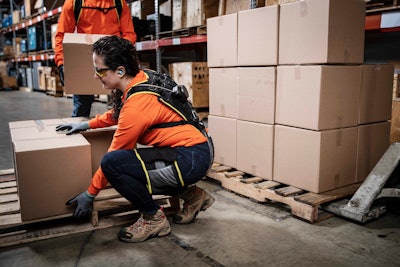
To enjoy the assistance of workforce wearables, workers must be willing to wear them.
Take for instance, John, warehouse stocker who had injured his back and was looking to get back to full duty. John became one of millions of Americans who missed time at work because of back pain.
Working as a morning stocker, John was on his feet for 8 hours, pushing and pulling pallet jacks full of goods, constantly lifting, bending and reaching to stock aisles.
John agreed to try using a back-assist exoskeleton while on modified duty. He used the exoskeleton until he no longer had any work restrictions from his doctor and was approved for full-duty work. He said he could feel the exoskeleton reducing strain in his back when he was bending and lifting. The assistance truly worked.
Then one day John returned the exoskeleton. Even though it worked, he didn’t want to use it anymore.
While there was no doubt that the exoskeleton helped, John said it prevented him from doing his job and moving the way he wanted. He couldn’t get close to the items he needed to reach because the exoskeleton interfered. He couldn’t move in tight spaces and in between pallets because the exoskeleton stuck out too far around his body and got caught on shrink-wrap.
It helped relieve back strain, but that didn’t matter. Because it got in the way, John was done with the exoskeleton.
Restrictive wearables face an uphill battle for adoption
John’s story is a powerful lesson -- if you are thinking about adopting new technology or new wearables for your workforce, physical assistance is not the only important factor.
Whether it’s an exoskeleton that provides physical support or sensors that promote a safer workday, if wearables prevent workers from doing their job how they want to, adoption will be an uphill battle.
That’s why comfortable workforce wearables that don’t restrict freedom of movement are more practical for many industries, especially fast-paced logistics environments. Logistics and warehouse workers need to be able to quickly adapt to any challenges, which means they need full mobility and zero distractions.
Lightweight, soft exosuits that are built to comfortably fit any body type and be worn all day have incredible potential to help workers who frequently bend and lift. Those are also the kind of workers that need protection.
The wear and tear from the frequent forces and awkward postures their spines must endure during all that bending and lifting really adds up physically – not only over the course of a single day, but also over the course of a career.
Exosuits and smart sensors
The good news is there are many new wearables for logistics companies wanting to find ways to protect their employees without sacrificing production.
Companies have started using workforce wearables, including rigid exoskeletons or “soft-shell” exosuits, to lower the forces that increase the risk of chronic pain.
These companies and many others are using exoskeletons and exosuits already on the market and have been scientifically proven to reduce back strain, fatigue and risk of injury from bending and lifting. But, as we learned from John’s story, it’s critical that they are comfortable and don’t restrict freedom of movement.
Thankfully, there are exosuits being implemented that are specifically designed to provide assistance without impacting mobility or comfort.
When it comes to the sensor side of workforce wearables, some companies are testing devices that alert workers engaging in risky movements. These devices collect data to give employers insights into which jobs, tasks or workers have the highest levels of injury risk, so that workplace design or equipment changes can be made to improve worker safety. They also provide feedback to workers to train them to avoid risky postures and movements. The testing found a reduction in injury risk across North America using the sensors.
But, while exosuits must give user’s freedom of movement to be adopted, sensors have their own user-adoption hurdles -- the “creepy factor” that some workers may feel toward data collection, including privacy and workplace-surveillance concerns.
Wearables can tackle expensive workplace injury problem
The rise of workforce wearables could help fight a major problem -- work-related musculoskeletal disorders (WMSDs).
OSHA said WMSDs are frequently the cause of lost or restricted work time and the annual cost from back pain domestically is $253 billion, according to the Bone and Joint Initiative.
Workforce wearables can help protect workers who may be at-risk of suffering WMSDs, which could turn into chronic pain. But, a major hurdle in the “war on WMSDs” is buy-in from the workers to properly use the wearables.
John’s story proved that buy-in is going to be a whole lot easier if the wearables are comfortable and maintain mobility.
To enjoy the assistance of workforce wearables, workers must be willing to wear them. When they feel comfortable using a wearable and quickly see the difference it makes by improving their quality of life, the way physical work is done can change forever.



















